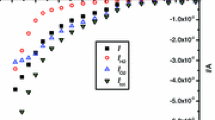Abstract
The temporal analysis of effluent species with temperature linearly increasing with time for two reactions, carbon dioxide hydrogenation (250° to 600°C) and the oxidative coupling of methane (400° to 800°C) have been studied. A non-stoichiometric, mixed-oxide catalyst, Li0.9Ni0.5Co0.5O2-δ, containing both mobile ions and electrons at elevated temperatures was investigated. The exit gas stream was monitored by using the multiple-ion monitoring facility of a quadrupole mass spectrometer. The AC electrical characteristics of the catalyst pellet between 100 Hz and 1 MHz were simultaneously monitored in-situ.
A clear correlation between catalytic behaviour and electrical properties was obtained. Frequency-dependent AC losses due to surface dipole effects were dominant during phases of strong chemisorption and reaction, whilst reversion to thermally activated behaviour occurred during times of reduced chemical activity.
In the case of carbon dioxide hydrogenation, the catalyst becomes partially reduced as a result of the chemical reaction, as shown by the changes in conductance-temperature-frequency characteristics. The original oxidised state could be recovered by re-oxidation at 700°C for 1 hour in air. For the partial oxidation of methane, mobile lattice oxygen participates in the reaction. The temporary changes in the state of oxidation of the catalyst during this reaction are correlated with changes in the electrical characteristics of the material.
Similar content being viewed by others
6. References
I. Saadoune and C. Delmas, J. Mater. Chem.6, 193 (1996).
E. Zhecheva and R. Stoyanova, Solid State Ionics66, 143 (1993).
G.G. Amatucci, J.M. Tarascon, D. Larcher and L.C. Klein, Solid State Ionics84, 169 (1996).
A. Ovenston, D. Qin and J.R. Walls, J. Mater. Sci.30, 2496 (1995).
A. Ovenston and J.R. Walls, J. Catal.140, 464 (1993).
O.V. Krylov, Catal. Today18, 209 (1993).
A.W. Sleight, in: “Solid State Chemistry of Compounds”, (Eds A.K. Cheetham and P. Day), OUP 1992 chpt. 5 pp166–181.
D. Qin, A. Villar, A. Ovenston and J.R. Walls, in: Proceedings of ACS symposium on “Heterogeneous Hydrocarbon Oxidation”, New Orleans, ACS Symp., Ser.638, 95 (1996).
A. Ovenston, D. Qin and J.R. Walls, J. Mater. Sci.31, 3375 (1996).
A. Ovenston, D. Qin and J.R. Walls, J. Mater. Sci., in press 1996.
L.D. Schmidt, M. Huff and S.S. Bharadwaj, Chem. Eng. Sci.49, 3981 (1994).
A.R. West, Presentation at the Dielectric Society Conference, Canterbury, April 1995.
J. H. Lunsford, Catal. Today6, 235 (1990).
J-L. Dubois and C.J. Cameron, Applied Catal.67, 49 (1990).
T-R. Ling, Z-B. Chen and M-D. Lee, Catal. Today26, 79 (1995)
M. Cãldãraru, personal communication
P.J. Gellings and H.J.M. Bouwmeester, Catal. Today12, 1 (1992).
Author information
Authors and Affiliations
Rights and permissions
About this article
Cite this article
Ovenston, A., Qin, D. & Walls, J.R. The AC monitoring of a mixed conducting Li-Ni-Co-O catalyst during temperature programmed reactions. Ionics 2, 123–131 (1996). https://doi.org/10.1007/BF02375805
Received:
Issue Date:
DOI: https://doi.org/10.1007/BF02375805




